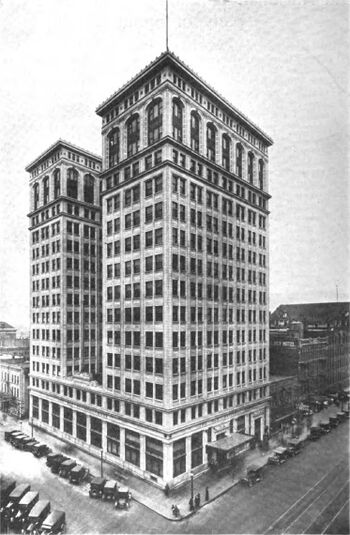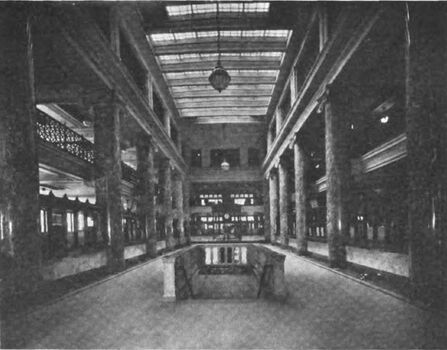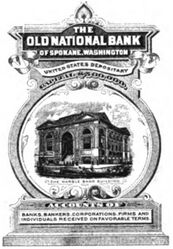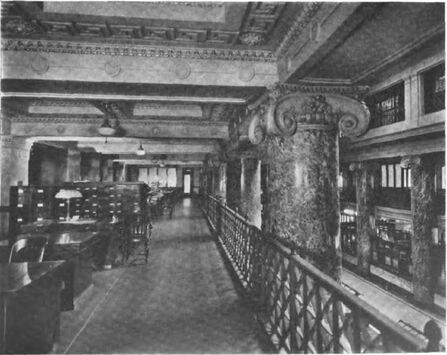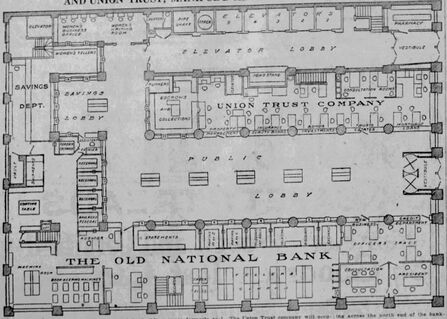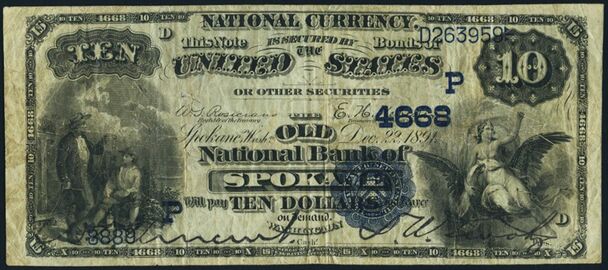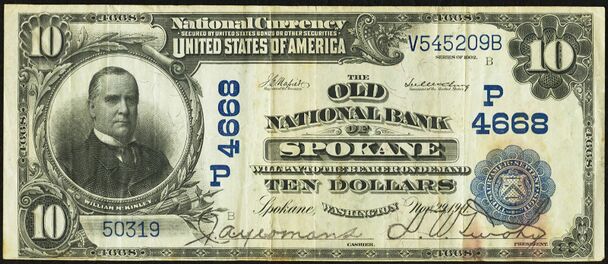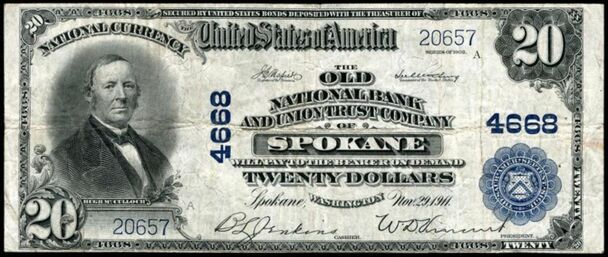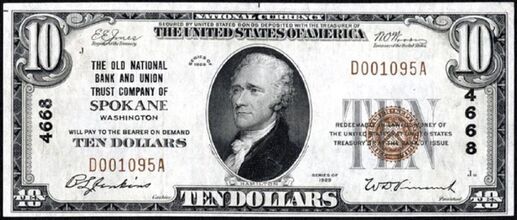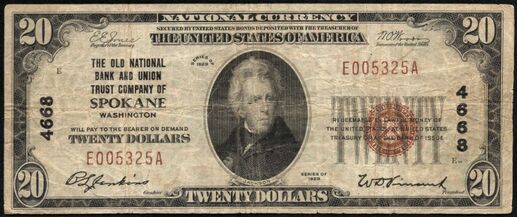Old National Bank/Old NB and Union TC, Spokane, WA (Charter 4668)
Old National Bank/Old NB and Union TC, Spokane, WA (Chartered 1891 - Open past 1935)
Town History
Spokane is the largest city and county seat of Spokane County, Washington. It is in eastern Washington, along the Spokane River, adjacent to the Selkirk Mountains, and west of the Rocky Mountain foothills, 92 miles south of the Canadian border, 18 miles west of the Washington–Idaho border, and 279 miles east of Seattle, along I-90.
The first people to live in the area, the Spokane tribe (their name meaning "children of the sun" in Salishan), lived off plentiful game. David Thompson explored the area with the westward expansion and establishment of the North West Company's Spokane House in 1810. This trading post was the first long-term European settlement in Washington. Completion of the Northern Pacific Railway in 1881 brought settlers to the Spokane area. The same year it was officially incorporated as a city under the name of Spokane Falls (it was re-incorporated under its current name ten years later). In the late 19th century, gold and silver were discovered in the Inland Northwest. The local economy depended on mining, timber, and agriculture until the 1980s. Spokane hosted the first environmentally themed World's fair at Expo '74.
The Old National Bank Building, is a high-rise in Spokane, Washington. Having been completed in 1910, it was the first skyscraper in the Inland Northwest. At 219 ft tall, the building was the tallest in the state of Washington from 1910 to 1911. D.H. Burnham and Co. of Chicago designed the building, which cost $1.3 million, in the Chicago School style of architecture. It used a steel frame construction, which was the style in the wake of the 1889 Spokane fire. For decades, the building was marked by a brightly lit “ONB” on the roof. Today the Old National Bank building is occupied by US Bank.
Spokane had nine National Banks chartered during the Bank Note Era, and all nine of those banks issued National Bank Notes.
Bank History
- Organized November 28, 1891
- Chartered December 22, 1891
- 2: Absorbed 12418 March 19, 1929 (Brotherhood's Co-operative NB/City NB, Spokane, WA)
- 2: Conservatorship March 14, 1933
- 2: Licensed October 7, 1933
- 2: Absorbed 5751 December 14, 1935 (First National Bank, Ritzville, WA)
- 2: Absorbed 8481 December 14, 1935 (First National Bank, Sunnyside, WA)
- 2: Absorbed 11546 December 14, 1935 (First National Bank (No Issue), Grandview, WA)
- 2: Absorbed 12180 December 14, 1935 (First National Bank (No Issue), Sprague, WA)
- 2: Absorbed 13444 December 14, 1935 (First National Bank, Reardan, WA)
- Bank was Open past 1935
On June 14, 1892, Mr. H. T. Fairlamb died at his residence on Adams Street. H. Townsend Fairlamb was born in Westchester, Pennsylvania in 1854. He graduated from Yale with the class of 1875 and was admitted to the bar in his native state. In July 1889, he moved to Spokane and assumed the management of the Pennsylvania Mortgage Investment Company. When the old National Bank of Spokane was organized a few months ago, he became one of the directors.
In December 1894, the Old national Bank had as officers S.S. Glidden, president; Moritz Thomsen, vice president; and Wm. M. Byers, cashier. The bank had capital paid in of $250,000.
In January 1907, the number of directors was increased from seven to nine. The officers were D.W. Twohy, president; Peter Larson, vice president; W.D. Vincent, cashier; W.J. Kommers and J.A. Yeomans, assistant cashiers. The directors elected were Peter Larson, Levi Ankeny, J.D. Farrell, T.J. Humbird, W.D. Vincent, D.W. Twohy, James C. Twohy, Thomas F. Wren, and J.P. McGoldrick. The new directors added were T.J. Humbird and J.P. McGoldrick. The bank had total resources of $6,975,178.03 with capital $500,000, undivided profits $133,447.06, deposits of $6,141,730.97, and circulation $200,000.
The Union Trust Company of Spokane, which was organized recently under the trust company act of the state of Washington, opened for business on Monday, March 18, 1907, with capital and surplus of $220,000. It occupied the first basement, or grade floor, in the Marble Bank building, corner of Riverside Avenue and Wall Street which had been extensively remodeled for the transaction of a trust and safe deposit business. The officers and directors were D.W. Twohy, president; W.J.C. Wakefield, vice president; Jas. C. Cunningham, secretary-treasurer; D.C. Corbin, Peter Larson, James Monaghan, John A. Finch, T.J. Humbird, Geo. S. Brooke, R.B. Paterson, Fred. B. Grinnell, J.P. McGoldrick, Jay P. Graves, T.L. Greenough, D.K. McDonald, and E.J. Roberts. In April, the Union Trust Co. purchased the D.C. Corbin property on Riverside and Stevens for $200,000. The plan for the property was to erect a large office building of 10 or 12 stories in about three years.
In February 1910, the top floor of the $1,000,000, 14-story skyscraper being erected at the corner of Riverside Avenue and Stevens Street by the Old National Bank was considered by the new Commercial Club for its headquarters. The committee to move the chamber of commerce was considering reserving the next floor below and also a floor for the headquarters of the National Apple show, the Dry Farming congress, the Interstate Fair, the 150,000 club, and the Inland Empire Hardware Dealers' Association.
On Tuesday morning, January 3, 1911, the Old National Bank opened for business in its new home in the Old National Bank building, corner of Riverside Avenue and Stevens Street. On New Year's Eve, the bank commemorated the occasion with an informal reception, lighting up the building and providing Reemer's orchestra of 16 pieces for the musical program.
In May 1917, the Union Trust Company occupied quarters specially remodeled for them along the east side of the main lobby of the Old National Bank building. On the mezzanine floor which extended across the north end of the banking rooms, the trust company would have 3,200 square feet of working space. "The new quarters will provide ideal accommodations for both institutions, " said W.J. Kommers, vice president of the Union Trust Co. "Moreover the patrons of both will have at their disposal a complete financial service under one roof." A greater degree of cooperation would be possible between the officers and staff of the Old National and Union Trust. Remodeling was expected to be completed for the June 9 opening date.
In January 1919, the joint board of directors of the Old National Bank and the Union Trust Company consisted of the following: August Paulsen, mine owner; T.J. Humbird, pres. Humbird Lumber Co., R.B. Paterson, Pres. Spokane Dry Goods Co.; P. Welch, railroad contractor; L.W. Hutton, mine owner; A.L. Flewelling, mines and timber; John Twohy, pres. Twohy Bros. Co., railroad contractors; Frank T. McCollough, secretary-treasurer, Crystal Laundry Co.; Jay P. Graves, mine owner; W.J. Kommers, vice president, Union Trust Co.; W.D. Vincent, vice president, The Old National Bank; D.W. Twohy, president; John D. Porter, president, Porter Bros., Co., railroad contractors; Thos. F. Wren, president, Wren & Greenough Land Co.; Austin Corbin, 2d vice president, Corbin Coal & Coke Co.; E.P. Twohy, attorney; J.P. McGoldrick, president, McGoldrick Lumber Co.; Jas. C. Cunningham, president, Cunningham Realty Co.; and W.J.C. Wakefield, attorney and counselor. The officers of The Old National Bank were D.W. Twohy, president; T.J. Humbird and W.D. Vincent, vice presidents; J.A. Yeomans, cashier; W.J. Smithson, G.H. Greenwood, J.W. Bradley, B.L. Jenkins, and E.P. Randall, assistant cashiers. Officers of the Union Trust Company were D.W. Twohy, president; W.J.C. Wakefield and W.J. Kommers, vice presidents; Frank C. Paine, secretary; Arthur S. Blum, treasurer; Harold E. Fraser, assistant secretary. The combined resources at the end of 1918 were over $25 million. Total resources of the national bank were $19,087,807.37. The Union Trust Co. had resources of $7,138,996.06 with over $10 3/4 million in additional trust business.
In January 1926, the officers of the Old National Bank were all re-elected and were D.W. Twohy, chairman; W.D. Vincent, president; T.J. Humbird, W.J. Smithson, and J.W. Bradley, vice presidents; G.H. Greenwood, cashier; B.L. Jenkins, E.P. Randall, W.E. Tollenaar, E.B. Hutcheck, and O.K. Moody, assistant cashiers. The officers of the Union Trust Company were also all re-elected and were D.W. Twohy, chairman; W.J. Kommers, president; W.J.C. Wakefield, Frank C. Paine, and Harold E. Fraser, vice presidents; George L. Kimmel, secretary; Lyman C. Reed, assistant secretary; F.D. Graff, treasurer; and A. F. Brunkow, assistant secretary.
On April 1, 1926, the Old Union National Bank and Union Trust company, heretofore affiliated, announced that the resources and service departments of the two institutions had been merged. A complete banking and trust business would be conducted by one organization, The Old National Bank and Union Trust Company, in the same quarters in the Old National Bank building. The banking department had $23 million in assets with $30 million in assets held in trust for a total responsibility of $53 million.
On December 14, 1935, of major importance to the financial structure of the Inland Empire was the action of the Old National Bank and Union Trust Company in converting a group of Inland Empire banks into nine branches of the Spokane institution. The move was of vital importance for two principal reasons: first, it made larger loans available locally in the area served by the branches and second, it brought closer the day when former depositors would recover their frozen funds. The loan a bank could make to any one creditor was limited to 10% of its combined capital and surplus, causing small banks to refuse, of necessity, many of the most desirable loans. The full loaning capacity of the Old National would now be behind each branch. Establishment of these banks as branches released some $450,000 capital toward repayment of the Investment & Securities company's RFC loan. Virtually all of the stock of these banks and the Old National, except that required to qualify directors, was pledged to the Investment & Securities company for repayment of the RFC loan and obligations to waiving depositors. Local economies would be bolstered by the inflow of much needed capital.
| Town | Bank | Manager | Assistant Manager |
|---|---|---|---|
| Davenport | Bank of Davenport | B.W. Hughes | W.K. Harper |
| Harrington | Harrington State Bank | J. Hopp, Jr. | L.C. Bailey |
| Reardan | First National Bank of Reardon | B.W. Hughes | L.B. Beavers |
| Ritzville | First National Bank of Ritzville | W.A. Pearce | H.E. Scholer |
| Sprague | First National Bank in Sprague | R.R. Jones | F.K. Kirchhoffer |
| Palouse | Security National Bank of Palouse | C.E. Funkhouser | J.C. Langdon |
| Prosser | Prosser State Bank | G.O. Bastien | E.W. Hovig |
| Grandview | First National Bank of Grandview | R.W. Duncan | R.W. Fleming |
| Sunnyside | First National Bank of Sunnyside | J.T. Robertson | H.L. Roy |
On December 19, 1935, Spokane was handed a Christmas present when more than $600,000 was made available to depositors of the Old National Bank and Union Trust Co. A 12% dividend on the certificates of depositors, representing that portion of the bank's deposits waived and withheld when the bank reorganized in 1933. At that time depositors received 40% of their funds and certificates in lieu of the waived 60%. Since reopening of the bank, the Investment and Securities company had reduced the original Reconstruction Finance Corporation (RFC) loan from $3,584,499.53 to $1,369,907.48. At the end of 1935, The Old National Bank and Union Trust Company had resources of $19,491,952.14 and operated branches in Davenport, Grandview, Harrington, Palouse, Prosser, Reardan, Ritzville, Sprague, and Sunnyside.
N.A. Telyea, president of the Old National Bank and Union Trust company, was appointed a director of the Spokane branch of the Federal Reserve Bank of San Francisco for a two-year term. His term started January 1, 1938. This vacancy was created by the expiration of the term of D.W. Twohy, chairman of the Old National. Mr. Telyea had been in the banking business over 33 years, starting in the First National Bank at Tekamah, Nebraska, in 1907. He was active in banking circles of South Dakota and Montana and had been associated with the government as bank examiner and also was connected with the War Finance Corporation. Mr. Telyea came to the Old National in October 1933.
In January 1939, the officers were N.A. Telyea, president; Albert E. Reid, executive vice president; W. Earl Tollenaar, A.G. Fleming, Claude L. Smith, vice president; Justin E. McWilliams, cashier; Roderick W. Jones, Frank M. Graff, Ralph M. Austin, and C.N. Carver, assistant cashiers; Elan R. Sweney, vice president and trust officer; Lyman C. Reed, assistant cashier and associate trust officer; Charles F. Hamlin, assistant cashier and associate trust officer.
The title of the bank was shortened to The Old National Bank of Spokane early in the 1940s. The bank merged with Peoples National Bank of Seattle to form US Bank of Washington in 1988, claiming $4 billion in assets and 140 branches around the state.
Official Bank Titles
1: The Old National Bank of Spokane, WA
2: The Old National Bank and Union Trust Company of Spokane, WA (4/5/1926)
Bank Note Types Issued
A total of $19,327,890 in National Bank Notes was issued by this bank between 1891 and 1935. This consisted of a total of 2,285,232 notes (1,745,184 large size and 540,048 small size notes).
This bank issued the following Types and Denominations of bank notes:
Series/Type Sheet/Denoms Serial#s Sheet Comments 1: 1882 Brown Back 3x10-20 1 - 14860 $10s with Abnormal Border Variety 1: 1882 Date Back 3x10-20 1 - 35000 $10s with Abnormal Border Variety 1: 1902 Date Back 3x10-20 1 - 46000 1: 1902 Plain Back 4x5 1 - 157504 1: 1902 Plain Back 3x10-20 46001 - 122883 2: 1902 Plain Back 4x5 1 - 65978 2: 1902 Plain Back 3x10-20 1 - 40071 2: 1929 Type 1 6x5 1 - 55337 2: 1929 Type 1 6x10 1 - 26718 2: 1929 Type 1 6x20 1 - 7953
Bank Presidents and Cashiers
Bank Presidents and Cashiers during the National Bank Note Era (1891 - 1935):
Presidents:
- Stephen S. Glidden, 1892-1902
- Daniel Webster Twohy Sr., 1903-1920
- William David Vincent, 1921-1932
- N. A. "Ned" Telyea, 1933-1935
Cashiers:
- G. W. James, 1892-1892
- William Mitchell Byers, 1893-1894
- William David Vincent, 1895-1911
- William David Vincent, 1913-1913
- Jay A. Yeomans, 1914-1919
- George H. Greenwood, 1920-1925
- Burtis L. Jenkins, 1926-1932
- Justin Earl McWilliams, 1933-1935
Other Known Bank Note Signers
- No other known bank note signers for this bank
Bank Note History Links
Sources
- Spokane, WA, on Wikipedia
- Don C. Kelly, National Bank Notes, A Guide with Prices. 6th Edition (Oxford, OH: The Paper Money Institute, 2008).
- Dean Oakes and John Hickman, Standard Catalog of National Bank Notes. 2nd Edition (Iola, WI: Krause Publications, 1990).
- Banks & Bankers Historical Database (1782-1935), https://spmc.org/bank-note-history-project
- The Bankers' Magazine, Vol. 77, July 1908-Dec. 1908, p. 248.
- The Bankers' Magazine, Vol. 106, Jan. 1923-June 1923, pp 1081-1084.
- Spokane Chronicle, Spokane, WA, Tue., June 14, 1892.
- Spokane Chronicle, Spokane, WA, Tue., Jan. 8, 1907.
- Spokane Chronicle, Spokane, WA, Tue., Jan. 29, 1907.
- Spokane Chronicle, Spokane, WA, Thu., Mar. 14, 1907.
- Spokane Chronicle, Spokane, WA, Sat., Apr. 13, 1907.
- Spokane Chronicle, Spokane, WA, Thu., Feb. 3, 1910.
- Spokane Chronicle, Spokane, WA, Sat., Dec. 31, 1910.
- Spokane Chronicle, Spokane, WA, Thu., May 10, 1917.
- Spokane Chronicle, Spokane, WA, Mon., Jan. 6, 1919.
- Spokane Chronicle, Spokane, WA, Wed., Jan. 13, 1926.
- Spokane Chronicle, Spokane, WA, Thu., Apr. 1, 1926.
- Spokane Chronicle, Spokane, WA, Tue., Dec. 17, 1935.
- Spokane Chronicle, Spokane, WA, Thu., Dec. 19, 1935.
- Spokane Chronicle, Spokane, WA, Mon., Jan. 13, 1936.
- The Spokesman-Review, Spokane, WA, Sat., Jan. 4, 1936.
- The Spokesman-Review, Spokane, WA, Sun., Jan. 8, 1939.
- The Spokesman-Review, Spokane, WA, Mon., Nov. 26, 2012. "Then & Now: Old National Bank."
